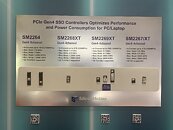Biostar is seemingly trying to become more competitive in the consumer motherboard market and although the company has some catching up to do with the tier one motherboard brands, the company has put out some more interesting products in the past couple of years. Its VX670E Valkyrie motherboard seems to sit near the middle of the X670E models that have been announced so far, although it's a little bit hard to tell, as the company only provided partial specs. As this is an AMD X670E based board, the PCIe x16 slot is using PCIe 5.0, although it's multiplexed with the second x16 slot, which means if both slots are used, the bandwidth drops down to eight lanes per slot. The board layout doesn't suggest any PCIe 5.0 M.2 slots, but as this is mandatory on X670E board, we have to presume that the M.2 slot right below the x16 PCIe slot, is the PCIe 5.0 one. The board has a further three M.2 slots, as well as what appears to be an empty M.2 E-keyed slot for a WiFi/Bluetooth module.
Other features listed by Biostar includes 2.5 Gbps Ethernet via a Realtek chip, HDMI and DisplayPort outputs, six SATA 3 ports, one rear and one front header for USB Type-C Gen 3.2 2x2 (20 Gbps) ports, as well as Realtek based audio and a pair of ARGB headers. The board also has a debug LED and a few buttons and switches for resetting the CMOS, and powering the board on. Interestingly, Biostar also provided figures for the memory clock speed, as the company listed support for up to four sticks of DDR5 memory at 5600 MHz plus. AMD has already demoed higher memory clocks of 6000 and even 6400 MHz during its keynote, as
supported by the footnotes that went alongside it, suggesting that this might just be a placeholder. Intel officially only supports 4800 MHz DDR5 memory, but speeds in excess of 6000 MHz doesn't appear to be an issue with the right motherboard and CPU combination. We'll have to wait and see what the official figures will be from AMD.





































































